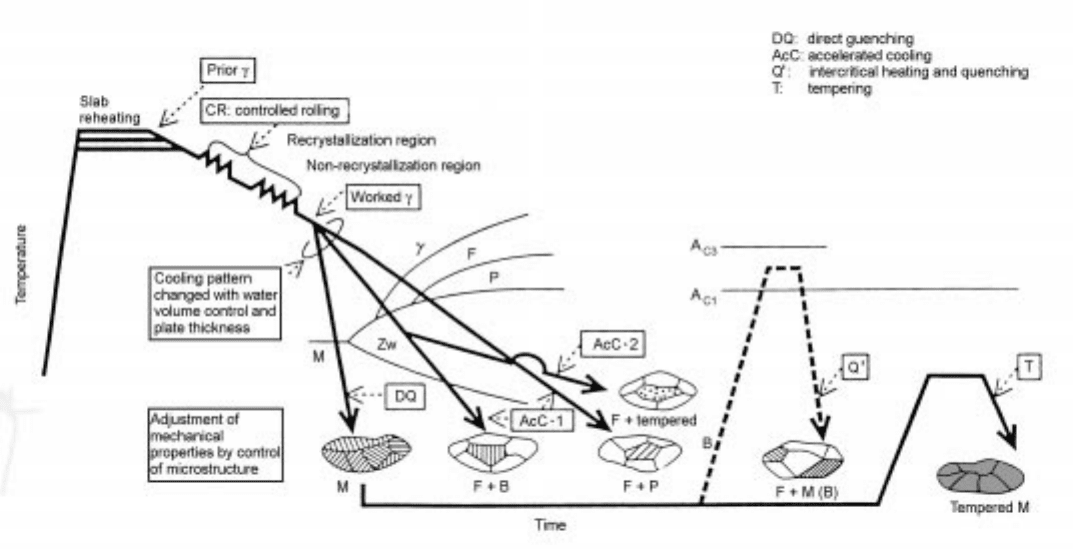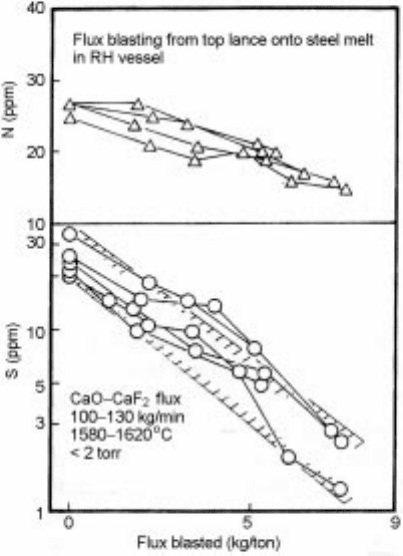Seetharaman S. Fundamentals of metallurgy
Подождите немного. Документ загружается.

process development. Thus, property and process are closely interlinked for
mutual progress. The integrated manufacturing system of BH-IF SEDDQ steel
sheet consists of unit processes listed in Table 13.1.
13.2.2 Processes driven by properties, environment and
energy
Piping for gas transmission is usually produced in large tonnage, sinc e pipelines
need to transmit a large volume of gas over a long distance from well site to
shipping port. High strength low alloy steel (HSLA) plate has been utilized for
making the pipe. HSLA contains C, Mn, Cu, Ni and Cr each in a small amount
depending on the mechanical and corrosion properties required. Also, some
microalloying elements, Ti, Nb, V and/or Mo are commonly utilized. The plate
is press formed into a U-channel, further pressed into an O-tube, and the seam is
submerged arc welded in length direction, and finished into pipe. This is called
UO pipe.
UO pipeline passing through Northern areas (e.g. the Trans-Alaska Pipeline
System, TAPS) demands superior low temperature ductility for security reasons.
Such ductility can be achieved by fine grain matrix of ferrite, , that is obtained
by recrystallizing fine grains of austenite, . Fine grains of diamet er d increase
TS or decrease the fracture appearance transitio n temper ature (FATT),
according to the Hall±Petch relation or Cottrell±Petch relation, each predicting
that YS/TS or FATT is positively or negatively proportional to (d)
ÿ0.5
.
Formerly, the grain refining was carried out by normalizing, i.e. heating hot
rolled HSLA plate just above Ar
3
transformation temperature to form fine
grains, and air cooling the plate to let the fine grains be transformed into fine
ferrite and pearlite. The normalizing process is, however, costly and low in
productivity. Elimination of the normalizing was trialed, and the thermo-
mechanical control rolling process (TMCP), later followed by accelerated
cooling, AcC, has been successfully industr ialized.
8
The success was due to
lasting development efforts, progress of most modern plate rolling mills, online
cooling facilities and advanced rolling and cooling schedules, combined with the
use of the microalloying elements in HSLA steels.
TMCP utilizes low temperature hot rolling of grains near Ar
3
temperature
to form fine recrystallized grains and non-recrystallized deformed grains as
shown in Fig. 13.7.
9
The deformed grains contribute more to refining grains
by providing a greater specific boundary area for the nucleation of an increased
number of grains. In addition, the deformed grains contain deformation
bands within a grain that also serve as nucleation sites for grains. Intensive
AcC after rolling generates intra-grain transformation nuclei that contribute to
refine grains as well. The AcC converts pearlite (forming on air-cooling) into
finely dispersed bainite that increases strength without impairing duct ility (see
AcC1 in Fig. 13.7). When the AcC is interrupted and taken over by air cooling
516 Fundamentals of metallurgy

13.7 Thermomechanical control process with accelerated
cooling for microstructure control of steel during hot rolling (
: austenite, F:
ferrite, P: pearlite, B: bainite, M: martensite), (Oosawa).
9
(interrupted accelerated cooling, IAC), the bainite becomes tempered bainite
(see AcC2 in Fig. 13.7). Strengthening by IAC includes refining of grains and
increase in precipitation hardening that make YS higher, and increase in volume
fraction of bainite that increases TS.
Microalloying of Nb, Ti and V forms very fine precipitates of Nb (C N), TiN
and VN that keep grains fine on reheating owing to their grain boundary
pinning effect. Grain growth of recrystallized is inhibited particularly by the
fine precipitates of TiN. Also, Nb and Ti dissolved in the matrix suppress
recrystallization on deformation, and increase Ar
3
in excess of 100K. This
makes the advantages of TMCP available at higher temperatures. Also, Nb, Ti
and V dissolved in matrix precipitate as fine carbonitride, carbide and nitride,
respectively, during and/or after ! transformation, and increase the strength
of matrix. In IAC, addition of Nb, Ti and V increases the quench sensitivity
and volume fraction of bainite, and hence strength.
The pipe is connected by girth welding in the open field without pre- and
post-heat treatment of the weld to save labor and cost. At such a weld,
coarsening of grains in the heat affected zone (HAZ) occurs to impair low
temperature ductility and strength, particularly for higher strength pipe grades.
Usu ally, C i ncreases strength but decreases both weldability and low
temperature ductility. To assure low temperature ductility of the seam- and
girth-weld, B-containing, low alloy steels bearing only low- to extra low-C have
been developed for higher strength variants. Loss of strength by decreasing C
has been compensated for by (a) further refining grains with fine TiN
precipitates, (b) hardening with Nb(CN) precipitates and (c) making texture
converted from ferrite±pearlite to bainite with the addition of B. If C content is
high, B is consumed as Fe
23
(CB)
6
which precipitates both at the boundaries and
in the matrix of grains, and hence cannot serve to form bainite. Decreasing C
to less than 0.04% by vacuum degassing of HSLA melt and combining excess C
with Nb and Ti as NbC and TiC prevent the formation of Fe
23
(CB)
6
.
API5LX-X60 a nd X65 UO pipe thus produced have found popular
application to gas/oil transmission for their reliability and good balance between
strength, low temperat ure ductility and weldab ility. However, higher tensile
grades, up to API5LX-X80, are required to reduce total cost, and hence have
found increasing use but yet in a limited amount. Recently, even API5LX-X100
(YS700, TS800 MPa) has been commercially utilized to cover some pipeline
in Canada. For such high strength grades, TMCP-AcC, shown in Fig. 13.7, has
been applied. The fine ferrite bainite structure is preferred for low FATT
values, and minimization of inclusions and precipitates are attempted for
securing ductility. An example of the chem istry for X100 is C 0.06, Si 0.1, Mn
1.8, Nb 0.04, Ti 0.01, Mo 0.2% and some Cu and Ni. To assure ductility of the
coarse grained heat affected zone (HAZ), control of Ti and N for refinement,
utilization of TiO
2
for fine nucl eation of , and reduction of Si, Al and C-
equivalent with B addition have been made.
518 Fundamentals of metallurgy

Gas and oil that contain H
2
S (sour gas and oil) have been increasing in their
production. H
2
S reacts with moisture in pipes, forms H
2
SO
4
which reacts with
the inner surface of the pipe wall to form active hydrogen atoms. When
desulfurization of steel melt is inadequate, MnS precipitates in steel slab during
solidification. Deformability of the MnS precipitates relative to the steel matrix
is high at plate rolling temperatures, and hence during cross-rolling they turn
into thin, two-dimensional shape inclusions with sharp periphery in the plate.
The hydrogen atoms diffuse into the pipe wall, and some of them recombine at
the incoherent interface of MnS precipitates and steel matrix to form H
2
molecules, causing decohesion of the interface.
Stress arising from the increasing pressure of the recombined H
2
gas
concentrates at the sharp peripheral edge of the deformed thin MnS where the
steel matrix has been made brittle by accumulated atomic hydrogen. Cracks
initiate there and propagate into the steel matrix around the periphery. If the
number density (number per unit volume) of the elongated MnS precipitates is
high, the crac k connects the prec ipitates stepwise in the thickness direction of the
pipe wall, finally causing a burst of gas/oil through the cracked pipe wall. This is
called hydrogen induced cracking (HIC). It is not only S but also C and P in steel
melt that can cause HIC. Both C and P segregate in the center-thickne ss of the CC
slab and hence the plate during rolling, forming hard and brittle pearlite banding
or martensite, causing brittle fracture there when extra stress is applied by the
recombined hydrogen gas. The through-thickness crack can propa gate in the
length direction of the pipe over 10 m before the gas is decompressed during
bursting. The burst can ignite the gas, causing fire and disaster in the area.
Measures that have been established to prevent the occurrence of HIC, and
process developments to execute these measures are given in Table 13.2. Most
Table 13.2 Measures and processes to prevent the occurrence of HIC in API5LX-
X60/65 pipeline for sour gas/oil transmission
Preventive measures Process to execute the measures
1 Make C low or extra low · Decarburization by BOF supplemented by RH
2 Minimize H, P, S (extra
low), oxide inclusions
· HMPT followed by LF + RH refining
3 Convert S dissolved in melt
into CaS
· Ca addition to steel melt in ladle/tundish
4 Minimize center- and grain
boundary-segregation of
C, P and S in slab
· Low superheat casting and elect romagnetic
flow control in mold to increase equiaxed
crystal in pool end of CC-slab.
· Electromagnetic stirring and soft reduction at
pool end to disperse solute e nriched melt in
the boundaries of equiaxed crystals
5 Fine grain bainite structure
with dispersed fine
precipitates
· TMCP and AcC of low C or extra low C HSLA
steel added with microalloying elements (Ti,
Nb, Mo, V, B)
Improving steelmaking and steel properties 519

important amon g them are (a) to desulfurize steel melt to extra low
concentrations (single ppm range) by HMPT and RH/LF (or LF only) with a
flux high in CaO (often CaO+CaF
2
for prompt melt ing) and (b) add Ca (often in
Fe-clad wire) to the desulfurized melt to convert remaining dissolved S into
solid CaS particles that do not deform in subsequent hot rolling. An example of
HMPT to desulfurize hot metal to 10 ppm by mixing hot metal with CaO+CaF
2
flux with a mechanical stirrer in the hot metal transfer ladle is shown in Fig.
13.8.
10
Another example of top injection of similar flux onto melt in RH vessel
to desulfurize steel to < 5 ppm is shown in Fig. 13.9.
11
CaS particles formed are
largely removed during the HMPT or RH processing. Center segregation of C
and P that occurs during CC is reduced in two ways. One is to disperse solute
enriched melt into the boundary area of sediment equiaxed dendrite crystals
13.8 Desulfurization of hot metal with CaO ± CaF
2
flux by impel ler stirring
(Ogawa et al.).
10
520 Fundamentals of metallurgy

where the solutes are less segregated. The other is to prevent inflow of solute
enriched interdendritic melt into the thin melt pool end of CC slab. The former
can be done by a combination of low superheat casting and electromagnetic melt
flow control in the mold that increases nucleation, growth and sedimentation of
equiaxed crystals. The latter is practiced by soft reduction of the pool end with
supporting roll pairs to prevent shrinkage-driven flow that is caused by
solidification. Also, the decreased C-equivalent mentioned above effectively
reduced the formation of the hard and brittle segregate zone.
In the pipeline case, the required properties demanded process developments
in steelmaking, casting, rolling and heat treatment that in turn have made the
production of HIC resistant pipe interactively possible up to X65 grade (X100 in
the near future).
13.2.3 Properties driven by processes
The ball bearing is one of the mos t important parts for rotating machines
including hard disc drives of PCs and engine and traction systems of
automobiles. Resistance to wear and fatigue cracking on rolling contact must
13.9 Desulfurization of steel in RH vessel with CaO±CaF
2
flux blasting through
top lance (Okada et al.).
11
Improving steelmaking and steel properties 521

be very high to assure durability of the machines, and hence surface hardness of
the bearing must be high with ductile interiors. Accordingly, high carbon
(~1%C) Al deoxidized steel with Cr has been used. As shown in Fig. 13.10,
12
fatigue limit expressed in terms of 10% failure life, B
10
, of typical ball bearings
was of the order of 10
6
rotation under a given test condition. Here, the bearing
was made of steel containing about 30 ppm of O that was mostly in the form of
oxide inclusions. The root cause of the failure was identified to be large
indigenous and exogenous oxide inclusions occurring during deoxidation and
casting of steel melt. The critical size of the large inclusions was roughly 30 m
but it has becom e sma ller, <15 m, as demands on fatigue life get more
stringent. It may be smaller in future.
To reduce the harm of the inclusions, ladle degassing was introduced which
effectively reduced total oxygen content, [O]
t
(sum of dissolved [O] in the melt
and O in the deoxidation product, Al
2
O
3
, suspending in the melt), in the high
carbon melt to 15 ppm. Later, RH process for more effective deoxidation under
vacuum has been implemented to make [O]
t
a low 8.3 ppm. The decrease of [O]
t
by ladle degassing and RH processing contributed greatly to reduce macro
inclusions. They were formed by the collision and agglomeration of fine Al
2
O
3
inclusions suspended in the melt during melt transfer, but not removed from the
13.10 Improvement of fatigue life of ball bearing with decreasing oxide
inclusion content by process development of steelmaking and casting
(Uesugi).
12
522 Fundamentals of metallurgy
melt. In addition, variation in the amount of exogenous macro inclusions
occurring from reoxidation by air and slag entrainment, and formation of macro
inclusion during solidification were much reduced by implementing continuous
casting (CC). As a resul t, [O]
t
decreased to less than 6 ppm. Further
implementation of bottom tapping (EBT) of EAF steel melt has effectively
reduced macro inclusions arising from the reoxidation of the melt by oxidizing
EAF slag and emulsification of the slag into the melt in the ladle. It is to be
noted that the macro inclusions are detrimental to fatigue life but their number
density is so small, and hence cannot be detected by total O analysis.
Later investigation on the critica l size of inclusions that influences fatigue life
has revealed that not only oxide inclusions but also Ti(C, N) inclusions, both in
excess of 15 m in size as mentioned before, are harmfu l. Accordingly, thorough
measures have been taken to minimize the numb er density of the two inclusions
larger than the critical size by attending to every possible source of O and Ti. The
sources of O were the reoxidation of Al-deoxidized melt by ladle refractory, ladle
glaze, air and oxidizing slag and entrainment of slag during melt transfer into the
CC-mold. The sources of Ti were inputs from ferroalloys added to the melt (>
15 ppm). These measures reduced O and Ti to 3.8 ppm and 5 ppm by 1996.
It must be noted that such a low total O only does not guarantee the absence
of inclusions larger than the critical size, since they occur by chance. However,
measures that consistently achieve total O of less than 4 ppm are more likely to
assure fewer num ber densities of such macro oxide inclusions. As a
consequence, the fatigue life has now exceeded 10
8
rotations, almost two
orders of magnitude of fatigue life prolongation. A recent concern is to reduce
the formation of large, hard octagonal spinel inclusions (MgOAl
2
O
3
). They
probably arise from the reaction between the suspending deoxidation product,
Al
2
O
3
, and Mg produced by the reduction of MgO in slag and refractory by Al in
the melt during intensive refining by stirring of the melt to remove the Al
2
O
3
inclusions.
13.3 Optimization of processes to meet properties and
productivity
To make steel, either the BF±BOF or scrap±EAF route combined with secondary
refining and casting processes is utilized. Function and characteristics of these
processes are summarized in Table 13.3 (see also Fig. 13.5). Depending on the
requirements specific to each grade of steel, one or two-in-series of the
secondary refining processes are chosen to bridge the primary steelmaking
process, BOF or EAF to CC. Investment, productivity, availability of iron
sources, cost of operation and versatility of operation to cover various steel
grades, all determine the choice. Matching of the production rate and cycle time
of processing among the BOF, EAF, secon dary refining process and CC should
be made consistent.
Improving steelmaking and steel properties 523

13.3.1 Processes to optimize impurities and alloying elements
Typical impurities found in steel are H, N, O (including oxide inclusions) P, S,
non-volatile tramp elements (Cu, Cr, Ni and Sn), and in some cases volatile tramp
elements (Zn, Pb, Sb and As). The impurities occur from hot metal (P, S), scrap
(P, S and tramp elements), ambient air (H, N and O) and refractory (O), and
adversely influence steel properties and may cause process upsets. The impurities
need to be removed below a critical concentration which is specific to a ste el
grade as roughly shown in Table 13.4. It depends often on subsequent processing
to semis or final products. To minimize the cost of removing the impurities, the
concentration of the impurities should be set somewhat lower (with tolerance
given for concentration variation occurring from process fluctuation and
segregation) but not excessively lower than the critica l one for cost reasons.
The tolerance depends much on the process itself and operational skill.
In the past, a combination of BOF or EAF with secondary refining was
adequate to remove the impurities to fulfill properties requirements. BOF or
EAF removed most of P and part of S into basic CaO-MgO-SiO
2
-Fe
t
O slag as
3CaOP
2
O
5
and CaS, and secondary refining removed the remainder of S. As the
properties requirements increased, P and S had to be further reduced. Process
optimization has been made first by improving secondary refining, and second
by adding HMPT for desulfurization to achieve lower S at a reasonabl e cost. So
Table 13.3 Function of secondary refining processes to reduce impurity elements
and inclusions, add alloys and control temperature
Process H C N O S P Alloy Temp Other features
RH S S S Y High speed mass processing
RH-KTB S SS W S M Y W RH with O
2
top blow
RH-PB S SS W S M Y W RH with flux side blow
RH-PI S SS W S S Y W RH with flux top blow
ASEA-SKF S S SS Y + Red S Magnetic stirring +
arc heating
LF S S SS Y + Red S Ar stirring + arc heating
AOD S S S S Y + Red S Ar+O
2
side blow, stainless
VAD S S Y + Red S Ar bottom bubbling in
vacuum
VOD S S M S Y + Red
Sameas above + O
2
top blow
TN M S Ca injection sulfide control
CAS M M Y Ar bottom bubbling + top
slag
CAS-OB W M M Y W
Same as above + O
2
top blow
HMPT S S See text
Note: Effectiveness of impurity removal or temperature controlis qualitatively shown by SS (super
strong removal to single ppm range), S (strong), M (modest) orW (weak). For alloying capability,Y
(yes) andY + Red (yes and reduction of alloy metal oxide possible)
524 Fundamentals of metallurgy

far, optimization has been proceeding toward splitting the original refining
function of the BOF into HMPT and secondary refining, leaving the BOF as a
decarburizer.
In Japan, BOFs operate at a higher hot metal ratio (roughly 90%) than in USA
and Europe (75%) owing to sufficient BF capac ity with its cost efficient
operation. HMPT for both dephosphorization and desulfurization has been
extensively developed and industrialized in most of integrated steel plants at
very high availability due to favorable thermal balance with the higher hot metal
operation. In fact, some plants are processing near 100% of hot metal by the
HMPT, making it possible to take advantages listed in Table 13.5. Strong
demands for steels extra low in P and S are behind the choice of this type of
HMPT which could as well be the case in industrially advanced countries in
future if demands for extra low P steels increase.
HMP T in this case is carried out in the following se quenc e: the
desiliconizing fluxes are blasted to hot metal with O
2
in the BF runner or
tilting tundish which distributes hot metal into transfer ladles. Low Si (0.3%)
operation of the BF, followed by desiliconization to 0.1%Si of hot metal
during tapping into the transfer ladle is preferred to realize the above-mentioned
advantages. The desulfurizing fluxes are either injected with N
2
into or mixed
with hot metal by mechanical- or gas-stirring in the hot metal transfer/ charging
vessels. The dephosphorizing fluxes are mostly injected into the hot metal
transfer vessels (torpedo- or ladle-type) with O
2
, with some top addition. Either
pre-mixed or post-mixed fluxes are used, but post-mixing seems to have
advantages in terms of cost and dynamic control of the process. For more
efficient refining with less slag, many efforts have been paid to find fluxes with
Table 13.4 Tolerable maximum inclusion sizes and impurity elements contents in
high performance steels
Application Key property Critical inclusion Critical impurity
size (m) content (ppm)
DI-can sheet Flange crack <40
SEDDQ sheet Average r > 2:0 C < 20, N < 30
Shadow mask Blur in etching <5 Low S
Lead frame Punch crack <5
Sour gas pipe HIC Shape control S<5
LNG plate Embrittlement P < 30, S < 10
Lamellar tear Z-crack Shape control ibid.
Bearing, race Rolling fatigue <10 O < 10, Ti < 15
Case hardening Fatigue crack <15 O < 15, Ti < 50
Tire cord Rupture Shape control < 20 Al < 10
Spring wire Fatigue Shape control < 20 ibid.
Improving steelmaking and steel properties 525
